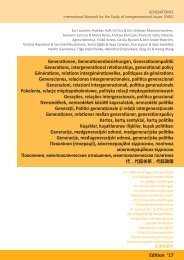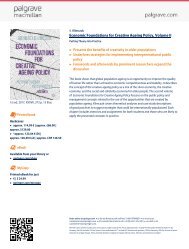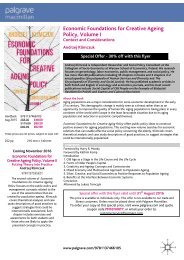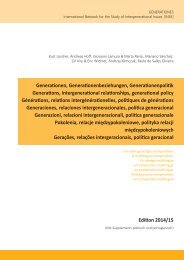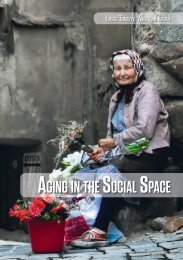Starzenie się populacji. Aktywizacja, koprodukcja i integracja społeczna osób starszych
Opracowanie ma charakter poglądowo-teoretyczny, powstało bowiem na podstawie przeglądu dostępnej literatury przedmiotu (polskiej i zagranicznej). Publikacja skierowana jest zarówno do naukowców jak i studentów zajmujących się tematyką starzenia się ludności, starości i osób starszych oraz do coraz szerszego grona zainteresowanych tymi zagadnieniami praktyków, w tym polityków i decydentów oraz reprezentantów usług publicznych, przedstawicieli mediów i organizacji pozarządowych. ** The study is illustrative and theoretical in nature, as it was based on a review of the available literature on the subject (Polish and foreign). The publication is addressed to both scholars and students dealing with the subjects of population ageing, old age, and older adults, as well as to a growing group of practitioners interested in these issues, including politicians and decision-makers as well as representatives of public services, the media, and non-governmental organizations.
Opracowanie ma charakter poglądowo-teoretyczny, powstało bowiem na podstawie przeglądu dostępnej literatury przedmiotu (polskiej i zagranicznej). Publikacja skierowana jest zarówno do naukowców jak i studentów zajmujących się tematyką starzenia się ludności, starości i osób starszych oraz do coraz szerszego grona zainteresowanych tymi zagadnieniami praktyków, w tym polityków i decydentów oraz reprezentantów usług publicznych, przedstawicieli mediów i organizacji pozarządowych.
**
The study is illustrative and theoretical in nature, as it was based on a review of the available literature on the subject (Polish and foreign). The publication is addressed to both scholars and students dealing with the subjects of population ageing, old age, and older adults, as well as to a growing group of practitioners interested in these issues, including politicians and decision-makers as well as representatives of public services, the media, and non-governmental organizations.
You also want an ePaper? Increase the reach of your titles
YUMPU automatically turns print PDFs into web optimized ePapers that Google loves.
180 Summary
scientific and expert circulation of many interpretations of changes related to the emergence
of post-industrial social policy. The structure of the presented study finally consists of parts –
chapters – prepared in such a way that, on the one hand, they constitute a coherent set verifying
and systematizing the concepts and interpretations of issues present in the literature, and
on the other hand, they clearly show the reader, in line with the authors’ acceptance, one of
the possible critical paths of analysis.
The first chapter is a kind of introduction to the discussed issues because its task is to
familiarize the reader with the interpretations of basic concepts functioning in the literature,
such as ageing, old age, and longevity, but also to serve as a reference to the category of immobile
people in working age or older people in the perspective of the life cycle. The theoretical,
conceptual framework identified in this way, associated with the population ageing
process, was supplemented with the presentation of demographic data aggregated at various
levels of generality, which refer to selected indicators and measures used in the statistical
analysis of the process discussed. In this way, the desired effect of multidimensionality has
been obtained, both in terms of theoretical considerations and in terms of the presentation
of statistical distribution reflecting the specificity of the dynamics of the ageing visible in the
European Union (EU) and Poland.
The second chapter is entirely focused on defining the concepts of activity, activation,
productivity, as well as social and professional integration of people in the age of immobility
and older adults. Therefore, the reader will find in it a critical literature review, which also
gives a chance to receive information about the connections between the issues mentioned.
Their significant supplementation is also a reference to the concept of productivity of older
people and the observed interpretation changes of this issue, manifested in the qualitative
expansion of the thematic planes that make up its conceptual framework.
In the third chapter, the authors attempt to present the differentiation of the concept of
public policy on ageing. Therefore, the reader can become familiar with the interpretations
of the impact of demographic changes and other conditions on post-industrial social policy
present in the literature on the subject. So, here the authors focus, among others, on the concepts
of active, coherent, and investment social policy implemented in the context of the ageing
process, but also references to selected concepts of stimulating social and professional activation
of people in immobile age and older adults. This is primarily about the social aspect of
productivity, the analyses of which, especially at the beginning of the 21st century, contributed
to a kind of restitution, an almost forgotten concept of co-production. Relating the conceptual
considerations in the literature concerning this phenomenon occurring and developing within
public services to the issue of the population ageing, the authors also present a silver (senior)
adaptation of co-production. The whole publication concludes with an analysis of the concept
of preparation for longevity and the potential application of behavioral economics tools in
public policy on longevity.
The publication is addressed both to scientists and students focused on the topic of
population ageing, old age, and older people, as well as to a growing group of practitioners
interested in these issues, including politicians and decision-makers, representatives of public
services, representatives of the media and non-governmental organizations. The authors
hope that the presented results of the conducted query will prove helpful for the reader both
in defining the conceptual framework of the issues under consideration and in attempts to
adapt and implement the assumptions of the concepts cited in the realities of the social life
of specific communities. Thus, the added value of the presented volume will be the systemic
valorization of old age, which–similarly to the earlier phases in human life–should serve further
development and self-realization.











